Maxar to begin production of new small satellite bus
Monday, 24 July 2023 15:52
Maxar Technologies announced July 24 that its new satellite bus designed for low Earth orbit constellations passed a critical design review.
Webb detects water vapour in rocky planet-forming zone
Monday, 24 July 2023 14:00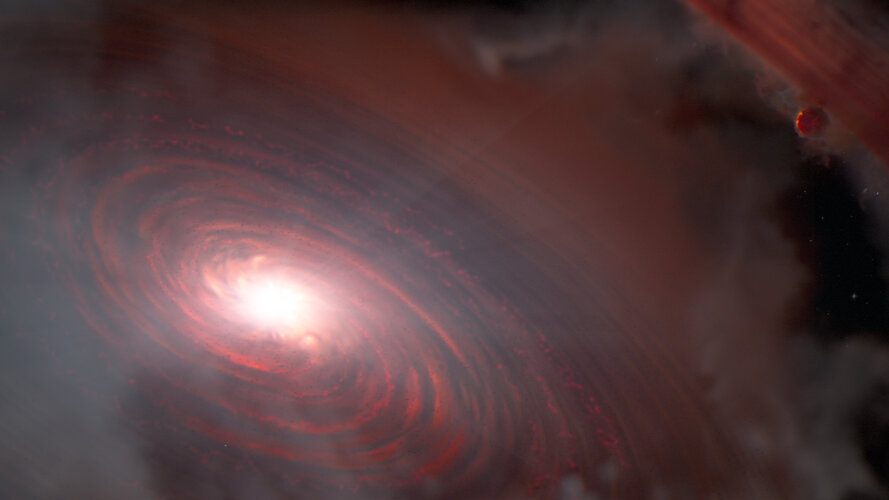
New measurements by the NASA/ESA/CSA James Webb Space Telescope’s Mid-InfraRed Instrument (MIRI) has detected water vapour in the inner disc of the system PDS 70, located 370 light-years away. This is the first detection of water in the terrestrial region of a disc already known to host two or more protoplanets.
China’s CASIC to begin launching VLEO satellites in December
Monday, 24 July 2023 13:20
Chinese space and defense contractor CASIC says it will begin building a constellation of 300 satellites in very-low Earth orbit late this year.
Rhodes wildfire forces thousands to flee
Monday, 24 July 2023 11:58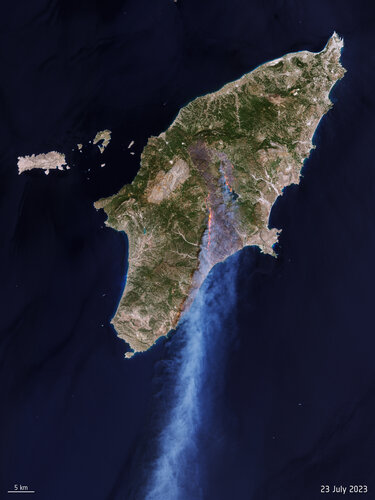 Image:
Rhodes wildfire forces thousands to flee
Image:
Rhodes wildfire forces thousands to flee New Galileo station goes on duty
Monday, 24 July 2023 09:12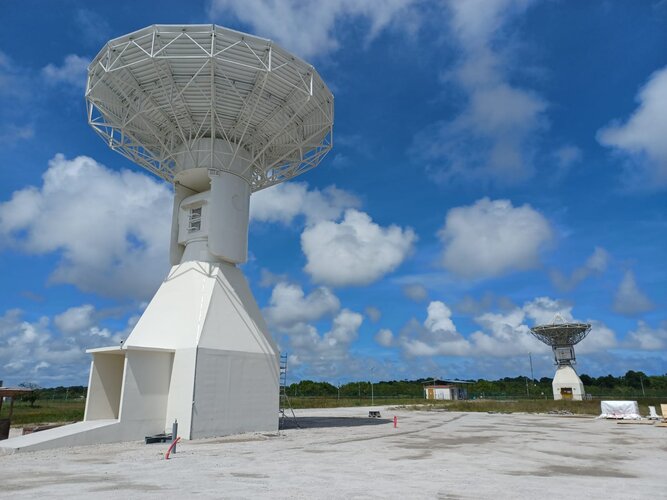 Image:
New Galileo station goes on duty
Image:
New Galileo station goes on duty OneSat’s robot arms enable fully European propulsion
Monday, 24 July 2023 08:14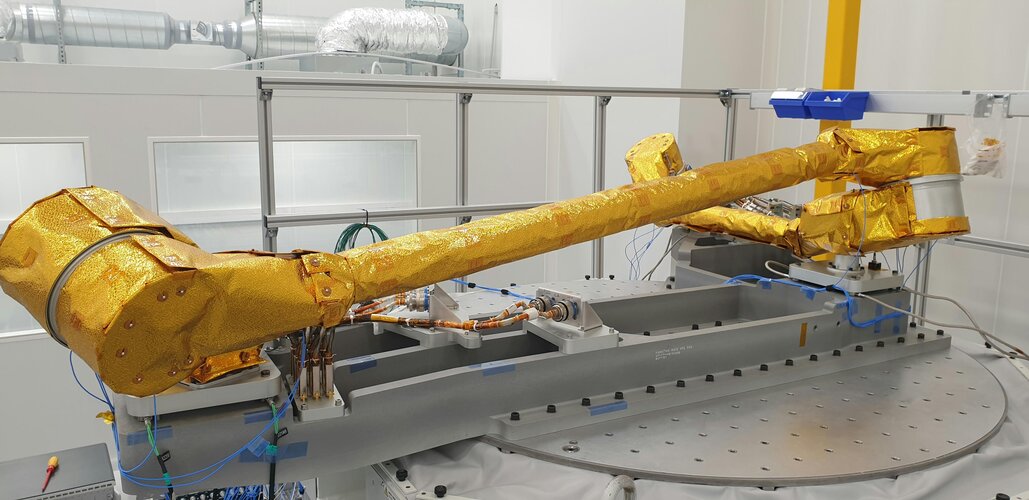
A robotic arm – entirely developed and built in Europe – that enables a satellite to change and control its orbit fuel efficiently has passed its qualification review for launch into space on the OneSat range of satellites.
Probe the space weather around Earth
Monday, 24 July 2023 08:00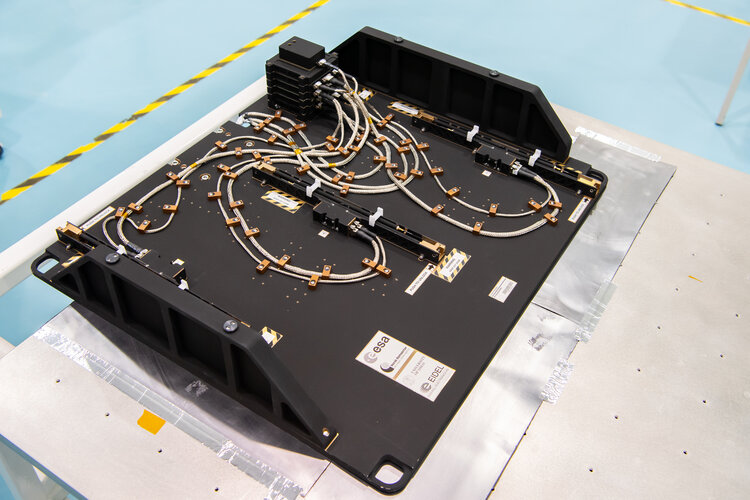
Launching soon on one of the next cargo missions to the International Space Station is the Multi-Needle Langmuir Probe that will measure the “weather” in the upper atmosphere. The experiment is part of ESA astronaut Andreas Mogensen’s Huginn mission climate science.
World Nano Foundation highlights nanotech's role in space materials science
Sunday, 23 July 2023 09:27 The World Nano Foundation (WNF), an international not-for-profit body dedicated to commercializing nanoscale technologies, has announced the publication of its latest white paper titled "Space Exploration: Unveiling the Potential of Nanotechnology in Advanced Materials Science." This document dives deep into the breakthroughs in materials science, which are propelling a revolution in space explo
The World Nano Foundation (WNF), an international not-for-profit body dedicated to commercializing nanoscale technologies, has announced the publication of its latest white paper titled "Space Exploration: Unveiling the Potential of Nanotechnology in Advanced Materials Science." This document dives deep into the breakthroughs in materials science, which are propelling a revolution in space explo Enabling autonomous exploration
Sunday, 23 July 2023 09:27 A research group in Carnegie Mellon University's Robotics Institute is creating the next generation of explorers - robots.
The Autonomous Exploration Research Team has developed a suite of robotic systems and planners enabling robots to explore more quickly, probe the darkest corners of unknown environments, and create more accurate and detailed maps. The systems allow robots to do all thi
A research group in Carnegie Mellon University's Robotics Institute is creating the next generation of explorers - robots.
The Autonomous Exploration Research Team has developed a suite of robotic systems and planners enabling robots to explore more quickly, probe the darkest corners of unknown environments, and create more accurate and detailed maps. The systems allow robots to do all thi Revolutionary materials and techniques transform aircraft construction
Sunday, 23 July 2023 09:27 For many decades, the aircraft industry has predominantly relied on aluminium for manufacturing. Today, however, the drive for more sustainable, climate-friendly air travel necessitates innovative solutions. In a groundbreaking development, the German Aerospace Center (DLR), in partnership with Premium AEROTEC, Airbus, and Aernnova, has presented a prototype for an entirely new approach to aircr
For many decades, the aircraft industry has predominantly relied on aluminium for manufacturing. Today, however, the drive for more sustainable, climate-friendly air travel necessitates innovative solutions. In a groundbreaking development, the German Aerospace Center (DLR), in partnership with Premium AEROTEC, Airbus, and Aernnova, has presented a prototype for an entirely new approach to aircr Amazon invests $120 million in internet satellite facility
Sunday, 23 July 2023 05:11 Amazon said Friday it will invest $120 million to build a satellite construction facility at NASA's Kennedy Space Center, as part of its plans to launch a space internet service to rival SpaceX's Starlink.
The company founded by Jeff Bezos says its "Project Kuiper" will provide "fast, affordable broadband to unserved and underserved communities around the world," with a constellation of more
Amazon said Friday it will invest $120 million to build a satellite construction facility at NASA's Kennedy Space Center, as part of its plans to launch a space internet service to rival SpaceX's Starlink.
The company founded by Jeff Bezos says its "Project Kuiper" will provide "fast, affordable broadband to unserved and underserved communities around the world," with a constellation of more SpaceX to launch more Starlink satellites after delays
Sunday, 23 July 2023 05:11 SpaceX, the space exploration company led by controversial billionaire Elon Musk, is scheduled to launch more Starlink satellites into low-Earth orbit late Saturday after delays earlier in the evening.
The company is now targeting 10:56 p.m. ET for a Falcon 9 launch from Space Launch Complex 40 at Cape Canaveral Space Force Base in Florida, according to a news release from the business
SpaceX, the space exploration company led by controversial billionaire Elon Musk, is scheduled to launch more Starlink satellites into low-Earth orbit late Saturday after delays earlier in the evening.
The company is now targeting 10:56 p.m. ET for a Falcon 9 launch from Space Launch Complex 40 at Cape Canaveral Space Force Base in Florida, according to a news release from the business NASA's Bill Nelson to discuss bilateral cooperation in South America
Sunday, 23 July 2023 05:11 NASA Administrator Bill Nelson will travel to South America on Monday to promote international cooperation on multiple space-related topics.
During his trip, Nelson will meet space officials in Brazil, Argentina and Colombia.
NASA says Nelson will meet the officials, including Argentinian President Alberto Fernandez, "to deepen bilateral cooperation across a broad range of innova
NASA Administrator Bill Nelson will travel to South America on Monday to promote international cooperation on multiple space-related topics.
During his trip, Nelson will meet space officials in Brazil, Argentina and Colombia.
NASA says Nelson will meet the officials, including Argentinian President Alberto Fernandez, "to deepen bilateral cooperation across a broad range of innova China develops new carrier rocket, spacecraft for moon landing
Sunday, 23 July 2023 05:11 China is currently developing a new carrier rocket and manned spacecraft as part of its goal to land astronauts on the moon by 2030, the country's space experts said.
The new carrier rocket Long March-10 is mainly developed for the purpose of sending spacecraft and moon lander into the Earth-moon transfer orbit, said Rong Yi, a rocket expert with the China Academy of Launch Vehicle Technol
China is currently developing a new carrier rocket and manned spacecraft as part of its goal to land astronauts on the moon by 2030, the country's space experts said.
The new carrier rocket Long March-10 is mainly developed for the purpose of sending spacecraft and moon lander into the Earth-moon transfer orbit, said Rong Yi, a rocket expert with the China Academy of Launch Vehicle Technol Perseverance sees Mars in a new light
Sunday, 23 July 2023 05:11 In its first 400 days on Mars, NASA's Perseverance rover may have found a diverse collection of organics - carbon-based molecules considered the building blocks of life - thanks to SHERLOC, an innovative instrument on the rover's robotic arm. Scientists with the mission, which is searching for evidence that the planet supported microbial life billions of years ago, aren't sure whether biological
In its first 400 days on Mars, NASA's Perseverance rover may have found a diverse collection of organics - carbon-based molecules considered the building blocks of life - thanks to SHERLOC, an innovative instrument on the rover's robotic arm. Scientists with the mission, which is searching for evidence that the planet supported microbial life billions of years ago, aren't sure whether biological 
